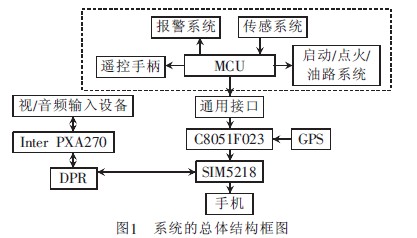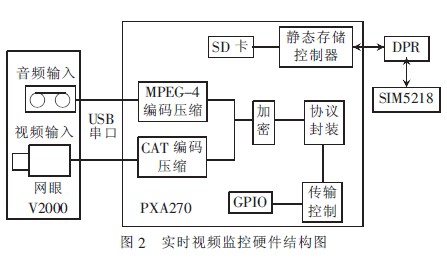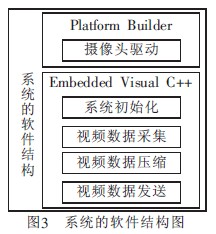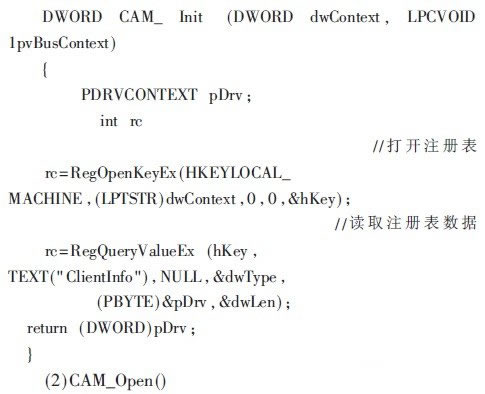introduction This article refers to the address: http:// With the mature development of the third generation mobile communication network, the application of video surveillance technology based on mobile communication networks is more and more widely used. Based on the advantages of high coverage, high reliability and fast transmission rate, this paper designs and implements visual monitoring of automobile anti-theft alarm system. Based on the existing electronic car burglar alarm, this design realizes the function expansion of the original alarm system of the car body by extending the general interface. The overall structural block diagram is shown in Figure 1. This paper focuses on the design and implementation of the video surveillance part of the system. The video monitoring part of the system is based on the hardware platform of InterPXA270 as the core, and realizes the upper layer application by constructing software development of embedded WindowsCE operating system. The design develops the camera driver by means of streaming interface, and realizes the real-time image data acquisition under the embedded WindowsCE by using the interface provided by the camera driver. The original image is encoded and compressed in MPEG-4 format, and the SCEET programming is implemented on the Windows CE side. Monitor the transmission of data. 1 hardware platform The structure of the existing automobile anti-theft alarm system is shown in the dotted line frame of Figure 1. This paper focuses on the design and implementation of the video monitoring part of this system. The hardware of the video monitoring part includes three parts, a camera that collects monitoring data, a multimedia processor, and a communication module. The hardware construction structure is shown in Figure 2. The hardware platform of the video monitoring part is based on the InterPXA270 processing chip of InterXScale microarchitecture, and the SIM5218 module is selected as the 3G communication module. The dual port RAM technology is used to realize the video processing and the overall structure of the system of Fig. 1 is the dual CPU of the 3G communication module. Communication between. Among them, the InterPXA270 chip's main frequency is 520Hz, and the WirelssMMX technology is added at the same time, which greatly improves the multimedia processing capability. In addition, PXA270's InterSpeedStep dynamic power management technology reduces the power consumption of the device while ensuring CPU performance. Siemens' 3G communication module SIM5218 supports data transfer rates up to 7.2Mb/s and provides UART, USB2.0, GPIO. And the rich peripheral interface such as I2C reduces the design difficulty; in this design, the camera selects the mesh 2000, which uses the OV511 chip as the core, has COMS 3 megapixel resolution, and uses USB communication, which can adopt the flow interface method in real time. Collect monitoring data. 2 software features The software architecture based on the Windows CE operating system consists of two parts. Using PlatformBuilder to customize WindowsCE system and develop USB camera driver and data sender development, this article details the design of USB camera driver and the program design of the sender. The software structure of the system is shown in Figure 3. The Windows CE stream interface driver is a driver with a custom interface, represented by a dynamic link library DLL at the user level, which is a generic type of device driver. The functions used to implement a fixed set of functions in a stream interface driver are called stream interface functions. These stream interface functions allow applications to access these drivers through the file system. The stream interface driver supports almost any type of external device that can be connected to a Windows CE.net-based platform, including USB devices. The main task of the stream interface driver is to pass the use of the peripheral to the application, which is implemented by representing the device as a special file of the file system. The application calls the stream interface function through the API function of the file system, and then the stream interface driver calls the native driver or interacts with the system kernel or peripheral through the device manager. 2.1 Implementation of the stream interface function of the camera driver Developing a camera driver involves a set of standard stream interface driver functions, such as CAM_Init(), CAM_Deinit(), CAM_Open(), CAM_Read(), etc. These functions are the interface driver's DLL interface, where CAM_Init(), CAM_Open(), CAM_Read(), and CAM_IOControl() are the most important. These important functions are described in detail below. (1) CAM_Init() The CAM_Init() function is called by the ActiveDeviceEx() function provided by the device manager. When the device is initialized, the device handle information is written to DriversActive through ActiveDeviceEx(). When the application is initialized, the address of the registry will be passed to CAM_Init() as the Context parameter, and the function will be opened by using RegOpenKeyEx(), RegQueryValueEx() and other functions. And read and write registry operations, etc. After the execution is successful, return the handle information of the USB device. Part of the source code for the driver: (2) CAM_Open() Before reading the device, first call CAM_Open() to open the device by executing CeratFile(). The first parameter required by CAM_Open() is the device handle returned by CAM_Init() when the application is initialized. Then set the device shutdown event to no signal state. The following is part of the source code:
Home and indoor or building air filters
remove unwanted particles like dust, pollen, pet dander and mold and ensure
even the most allergy prone can breathe easily year–round. However, choosing
the right filter for your home can be a rather involved process. To help, here
are the most common indoor air filters and what each of them provides. The
filters are the simplest basic component for air filtration solution through
your heating and cooling system ,It is important that you constantly monitor
the buildup of debris on these filters as well because it can easily be
recycled into the air supply. It is easy change and maintain.
Indoor Air Purification Filter & Air purifier filter Air Filter, Indoor Air Purification Filter,Building Air Purification Filter,Panel Air Filter Donguan Bronco Filter Co., Ltd , https://www.broncofilter-cn.com



